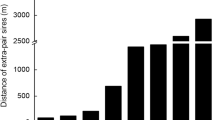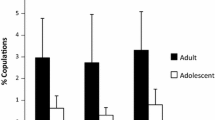Abstract
Mating behavior and paternity of offspring of wild patas monkeys were studied at Kala Maloue National Park, Cameroon. Observation of patas groups over three years revealed that multi-male situations occurred after takeover of the position of a resident male. Direct observation of behavior showed that resident males (harem males) occupied only 31% of mating in multi-male situations and 100% in one-male situations. DNA-typing revealed that resident males sired two of four of infants in the one-male situation and four of five in the multi-male situation. Under the two years cycle of the one-male situation and the multi-male situation, calculation shows that resident males sired more offspring than sneakers both in observation and paternity testing. Sneak mating occurred during both one-male and multi-male situations, and resident males performed compensatory mating, with dilution of sneaker sperm; these activities explain the discrepancy found between observation of mating and results of paternity discrimination.
Similar content being viewed by others
References
Chism, J. B. &T. E. Rowell, 1986. Mating and residence patterns of male patas monkeys.Ethology, 72: 31–39.
Cords, M., 1984. Mating patterns and social structure in red-tail monkeys (Cercopithecus ascanius).Z. Tierpsychol., 64: 313–329.
————, 1987. Forest guenons and patas monkeys: male-male competition in one-male groups. In:Primate Societies,B. B. Smuts,D. L. Cheney,R. M. Seyfarth,R. W. Wrangham, &T. T. Struhsaker (eds.), Univ. of Chicago Press, Chicago & London, pp. 98–111.
————, 1988. Mating systems of forest guenons. In:A Primate Radiation: The Evolutionary Biology of the African Guenons.A. Gautier-Hion, F. Bourliere, J. P. Gautier, &J. Kingdon (eds.), Cambridge Univ. Press, Cambridge, pp. 323–339.
————, B. J. Mitchell, H. M. Tsingalia, & T. E. Rowell, 1986. Promiscuous mating among blue monkeys in the Kakamega forest, Kenya.Ethology, 72: 214–226.
Dutrillaux, B., M. Muleris, &J. Couturier, 1988. Chromosomal evolution of Cercopithecinae. In:A Primate Radiation: The Evolutionary Biology of the African Guenons,A. Gautier-Hion,F. Bourliere,J. P. Gautier, &J. Kingdon (eds.), Cambridge Univ. Press, Cambridge, pp. 150–159.
Enomoto, T., 1978. On social preference in sexual behavior of Japanese monkeys (Macaca fuscata).J. Human Evol., 7: 283–293.
Gross, M. R. &E. L. Charnov, 1980. Alternative male life histories in bluegill sunfish.Proc. Nat. Acad. Sci. USA, 77: 6937–6940.
Harding, R. S. O. &D. K. Olson, 1986. Patterns of mating among male patas monkeys (Erythrocebus patas) in Kenya.Amer. J. Primatol., 11: 343–358.
Hill, W. G., 1987. DNA fingerprints applied to animal and bird populations.Nature, 327: 98–99.
Inoue, M., F. Mitsunaga, H. Ohsawa, A. Takenaka, Y. Sugiyama, A. G. Soumah, &O. Takenaka, 1991. Male mating behavior and paternity discrimination by DNA fingerprinting in a Japanese macaque group.Folia Primatol., 56: 202–210.
————, A. Takenaka, S. Tanaka, R. Kominami, & O. Takenaka, 1990. Paternity discrimination in a Japanese macaque troop by DNA fingerprinting.Primates, 31: 563–570.
———— &O. Takenaka, 1993. Japanese macaque microsatellite PCR primers for paternity testing.Primates, 34: 37–45.
Jeffreys, A. J., V. Wilson, &S. L. Thein, 1985. Hypervariable ‘minisatellite’ regions in human DNA.Nature, 314: 67–73.
Kominami, R, K. Mitani, &M. Muramatsu, 1988. Nucleotide sequence of a mouse minisatellite DNA.Nucleic Acids Res., 16: 1197.
Maynard Smith, J., 1982.Evolution and the Theory of Games. Cambridge Univ. Press, Cambridge.
———— &G. A. Price, 1976. The logic of animal conflict.Nature (London), 264: 15–18.
Ohsawa, H., 1991. Takeover of a one-male group and the subsequent promiscuity in patas monkeys. In:Primatology Today,A. Ehara,T. Kimua,M. Iwamoto, &O. Takenaka (eds.), Elsevier, Amsterdam, pp. 221–224.
Olson, D. K., 1985. The importance of female choice in the mating system of wild patas monkeys.Amer. J. Phys. Anthropol., 66: 211.
Ruvolo, M., 1988. Genetic evolution in the African guenons. In:A Primate Radiation: The Evolutionary Biology of the African Guenons.A. Gautier-Hion, F. Bourliere, J. P. Gautier, &J. Kingdon (eds.), Cambridge Univ. Press, Cambridge, pp. 127–139.
Struhsaker, T. T. &J. S. Gartlan, 1970. Observations on the behavior and ecology of the patas monkey (Erythrocebus patas) in the Waza Reserve, Cameroon.J. Zool. Soc. Lond., 161: 49–63.
Takahata, Y., 1982. The socio-sexual behavior of Japanese monkeys.Z. Tierpsychol., 59: 89–108.
Tsingalia, H. M. &T. E. Rowell, 1984. The behaviour of adult male blue monkeys.Z. Tierpsychol., 64: 253–268.
Wetton, J. H., R. E. Carter, D. T. Parkin, &D. Walters, 1987. Demographic study of a wild house sparrow population by DNA fingerprinting.Nature, 327: 147–152.
Author information
Authors and Affiliations
About this article
Cite this article
Ohsawa, H., Inoue, M. & Takenaka, O. Mating strategy and reproductive success of male patas monkeys (Erythrocebus patas). Primates 34, 533–544 (1993). https://doi.org/10.1007/BF02382664
Received:
Accepted:
Issue Date:
DOI: https://doi.org/10.1007/BF02382664




